The orange is a perfect choice for a fresh and healthy juice. But with so many different kinds of oranges, it can be tough to know how to choose the best oranges for juicing.
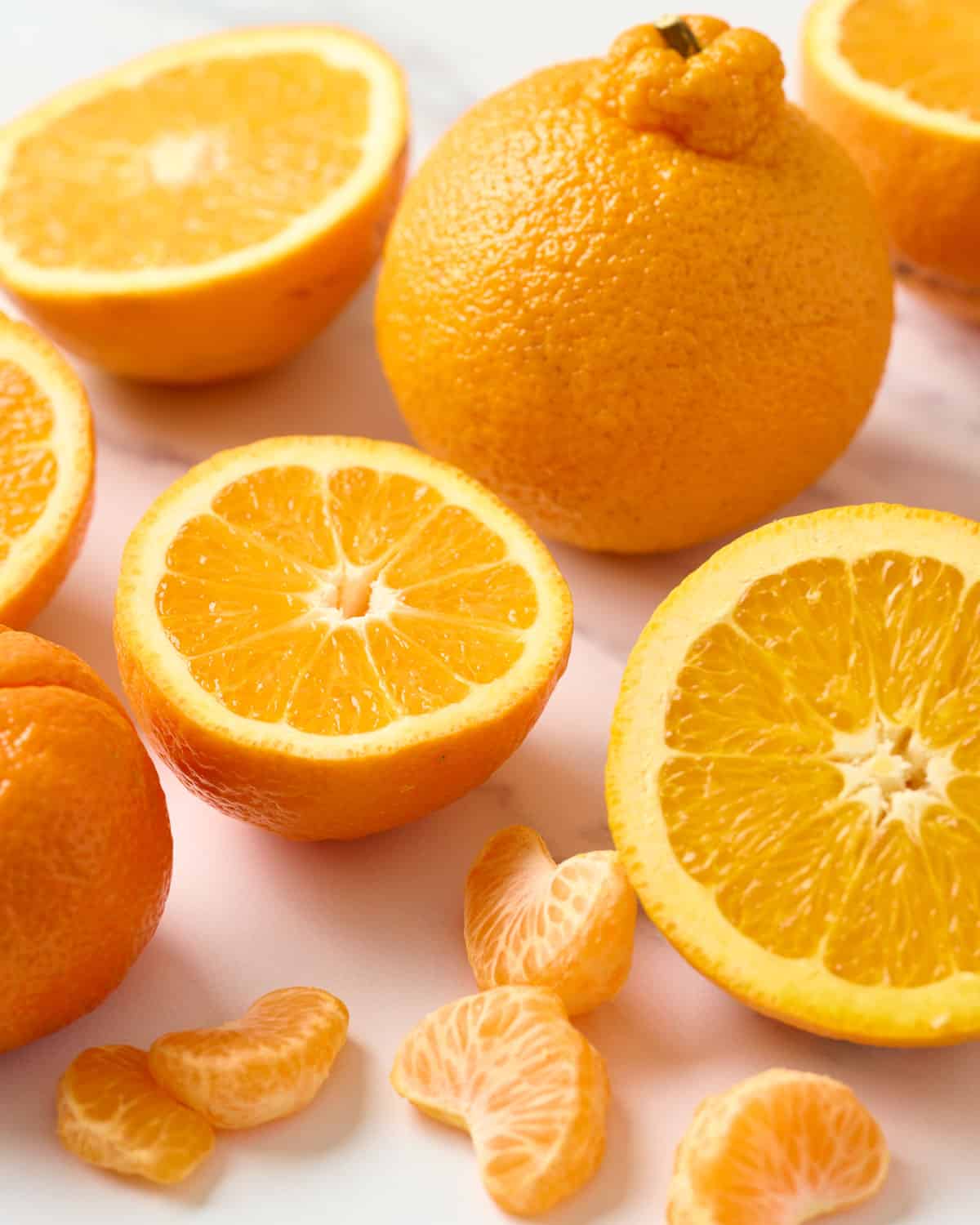
There’s nothing better than fresh squeezed orange juice, with its deliciously sweet flavor and boost of Vitamin C. It is such a versatile and delicious juice, used alone or in everything from cocktails (hello skinny margarita), to citrus juice (grapefruit orange juice) or green juice (green goddess juice) to smoothies and used a lot in cooking Mexican proteins (like carnitas and barbacoa).
In this post, we will take a closer look at some of the best 13 oranges for juicing, ranked from best to worst. Information includes their flavor profile, along with pros and cons to juicing them.
Jump to:
- What Types of Oranges do Store Bought Brands Use?
- Why Make Your Own Juice Rather Than Buy From the Store?
- How to Make Freshly Squeezed Orange Juice
- Best Oranges for Juicing (in Order)
- Valencia Oranges
- Cara Cara Oranges
- Mandarins
- Tangerines
- Clementines
- Sumo Oranges
- Blood Oranges
- Navel Oranges
- Tangelo Oranges
- Hamlin Oranges
- Lima Oranges
- Pineapple Oranges
- Seville Oranges
- Tips for Juicing Oranges
- FAQs
- Recipes using Oranges
- 💬 Comments
No matter what level of juicer you are, you’ll learn plenty of helpful information to help you make your own orange juice!
If you're a beginner juicer or are looking for more information on juicing, check out my Ultimate Guide to Juicing. You'll find everything from what type of juicer to buy (if you even need one at all!), juicing speeds for 40+ ingredients, and juicer best practices so you feel confident when juicing.
What Types of Oranges do Store Bought Brands Use?
When it comes to store-bought brands of orange juice, they typically use a variety of oranges, with the most common being Valencia and navel oranges. These varieties are known for their high juice content and sweet flavor, making them ideal for juicing.
Valencia oranges are especially popular for their excellent juicing qualities as they are juicy, easy to squeeze, and have a good balance of sweetness and tartness. Navel oranges, on the other hand, are known for their seedless nature and rich, sweet taste, which enhances the flavor of the juice.
Store-bought brands may also incorporate different types of oranges into their juice blends to add unique flavors or health benefits. For example, blood oranges are often included for their vibrant red color and distinct, tangy taste. These oranges are high in antioxidants, vitamin C, and anthocyanins, which give them their deep red hue.

Why Make Your Own Juice Rather Than Buy From the Store?
Orange juice sitting on the shelves at your local grocery store often consists heavily of water and sugar, diluting the natural sweetness of the oranges and adding sugar that isn’t always necessary. Oranges are juiced in large factories by large machines as quickly as possible, often damaging the vitamins and nutrients supplied by the fruit itself.
Orange juice is often pasteurized and reduced to a concentrate to allow for easier shipping and storage. Then water and other fruit concentrates are added back to the orange concentrate later in the process along with synthetic vitamins, minerals, flavorings, sweeteners, colors, etc.
By making your juice at home, you know exactly what you are drinking and you absorb all the natural vitamins and health benefits that oranges offer. You can then adjust your flavor by adding other varieties of oranges or other fruits to increase sweetness, or add a bit of water if you need to dial it back.
If you want to read more about the health benefits of making your own orange juice, check out Health Benefits of Orange Juice by Health.com.
How to Make Freshly Squeezed Orange Juice
The most common and easiest way to make freshly squeezed orange juice is to slice oranges in half and squeeze them by hand, using a citrus juicer, or using a citrus reamer. You simply press the cut side of the orange onto the sharp edge of the juicer or reamer and apply pressure so the juice comes out.
Most juicers or reamers have an area that collects the pulp, which you can either reuse, compost, toss, or add to your juice (if you’re the pulp type!). You can even freeze the peels to serve sorbets in or to garnish a cocktail!
Check out my fresh squeezed orange juice recipe for more!
Best Oranges for Juicing (in Order)
So without further ado, in ranking order from best to least favorite, here are the best types of oranges for juicing:
Valencia Oranges
Valencia oranges are the absolute best orange for juicing! They are the most juicy and are typically used for orange juice, as they are just sweet enough, seedless and large enough to juice easily.
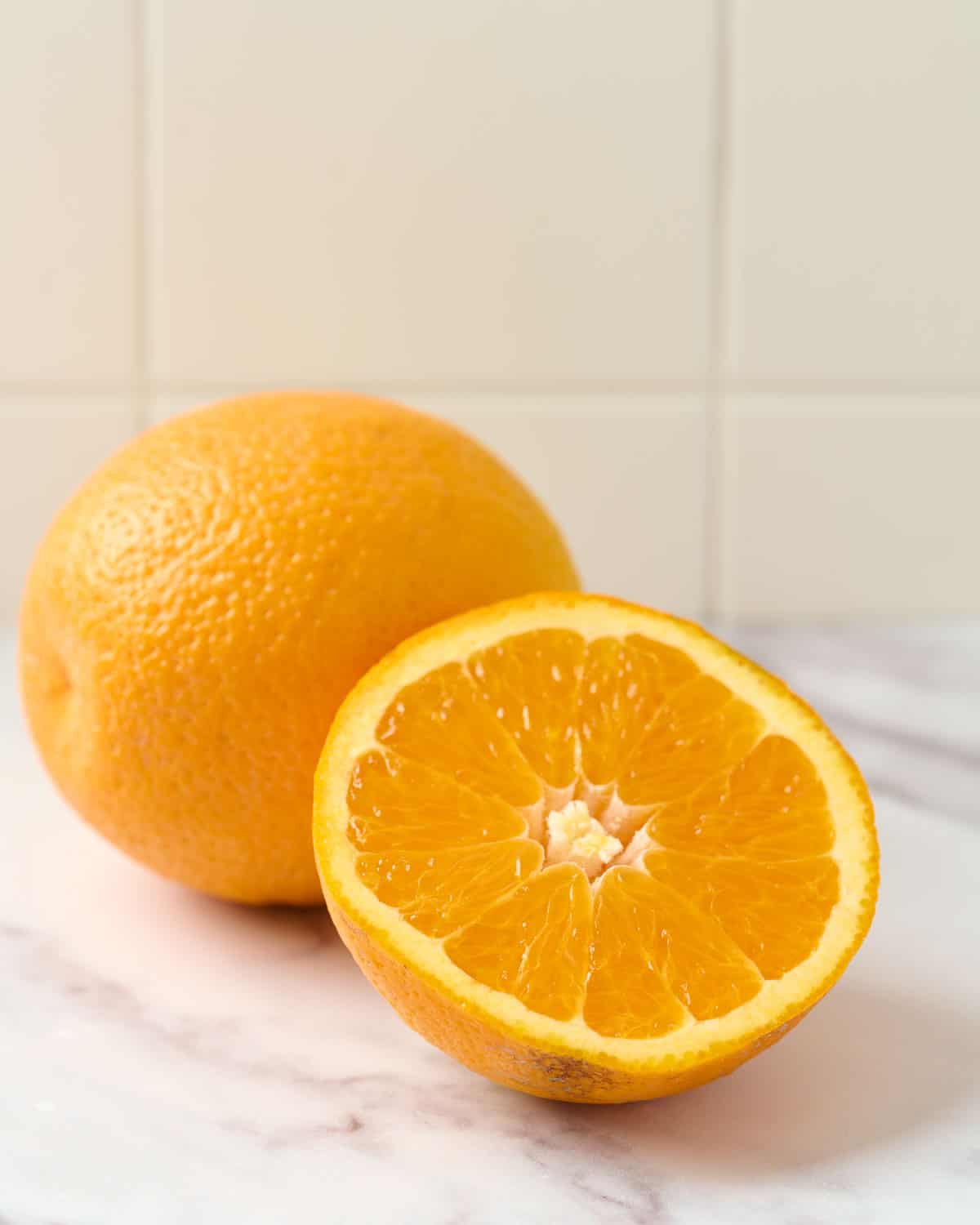
Commercially grown in Florida and my home state of California, the valencia orange is abundantly available. They are commonly available year round but their peak season ranges from March to June (although it may range depending on your location).
Valencia oranges are the chosen citrus when I purchase fresh squeezed orange juice from the farmer’s market or make orange juice at home.
| Pros | Cons |
|---|---|
| Contain few seeds | May be expensive in your store |
| Juicy | |
| Large in size making them easy to juice | |
| Commonly available |
Cara Cara Oranges
The cara cara orange, a type of navel orange, is another popular addition to orange juice. They have a slightly lower acidity than other oranges, offering a sweeter taste.
Cara Cara oranges are harvested in my home state of California! Cara Cara’s are peak season from December to April. These are very sweet so you may not need to add extra sweetener!
| Pros | Cons |
|---|---|
| Contain few seeds | Maybe overly sweet for some tastes |
| Juicy | |
| Large in size making them easy to juice |
Mandarins
Mandarins are different from oranges, but from the same species. All mandarin varieties (tangerines, clementines and satsuma oranges) can definitely be used to make orange juice, however they are sweeter than the typical orange.
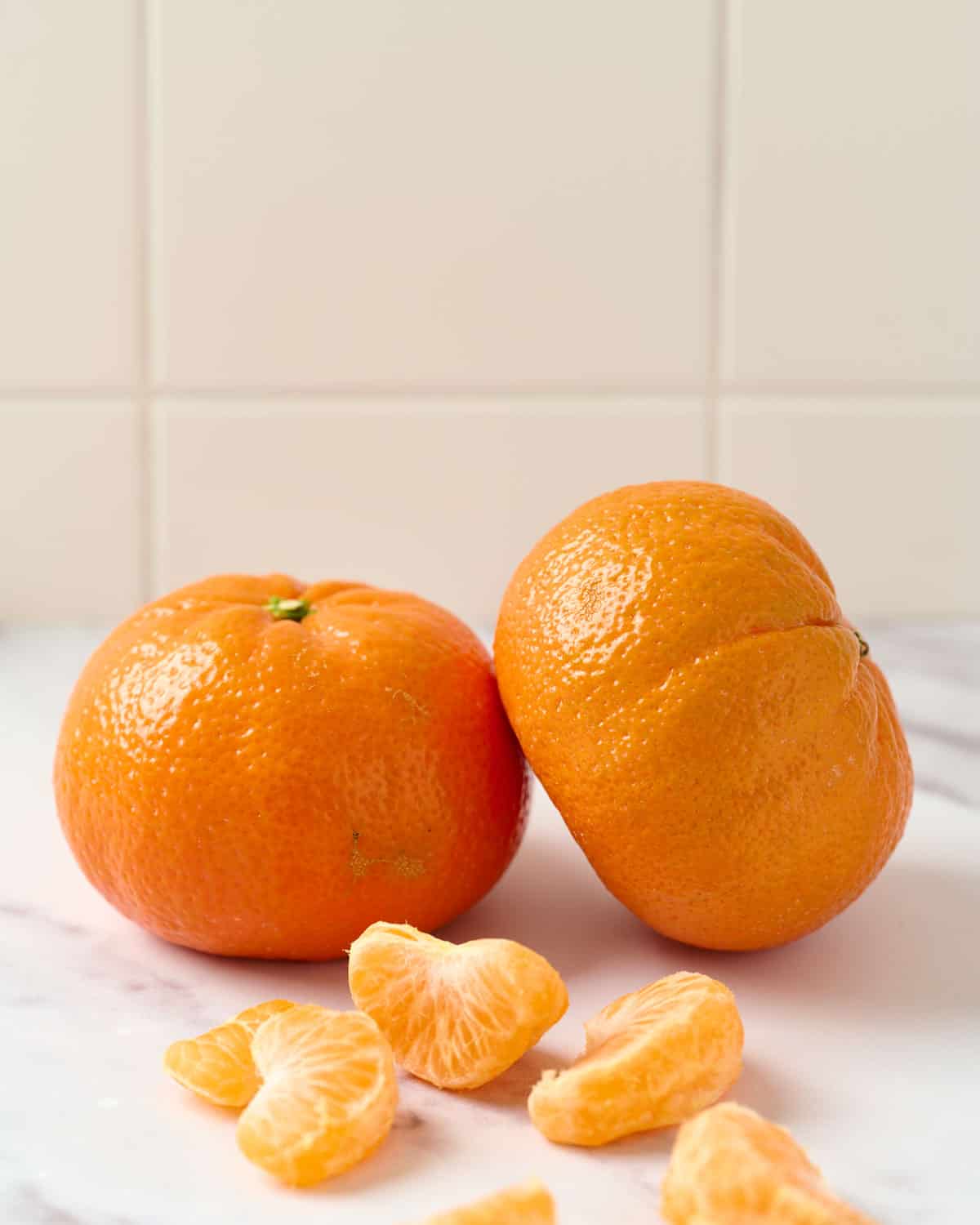
To make an orange juice using mandarins, you won’t need to add any sugar. In fact, in my Mandarin Juice recipe, I actually suggest balancing out the sweetness of mandarins with some water and adding lemons for tartness.
Because mandarins are smaller in size, I recommend juicing them with a blender!
| Pros | Cons |
|---|---|
| Contain little to no seeds | May be overly sweet |
| Juicy and sweet | Small in size - must blend them |
Tangerines
Tangerines are a variety of mandarins and can definitely be used in substitution for oranges. However, they are sweeter than the typical orange. You won’t need as much sugar in your orange juice if you use tangerines.
Because tangerines are smaller in size, I recommend juicing these by blending them. You can use them as a substitute in my Mandarin Juice.
| Pros | Cons |
|---|---|
| Contain little to no seeds | May be overly sweet |
| Juicy and sweet | Small in size - must blend them |
Clementines
Clementines, a combination of tangerines and oranges, are a great option for juicing because you can remove the peel by hand. You have very likely heard them by the trademark name of Cuties or Halos.
They’re tiny, so you need more clementines to make juice. I would recommend a blender for these to significantly speed up the process.
| Pros | Cons |
|---|---|
| Contain little to no seeds | May be overly sweet |
| Juicy and sweet | Small in size - must blend them |
Sumo Oranges
Sumo citrus oranges are a type of large orange variety known for its top knot looking top, reminiscent of sumo wrestlers - exactly where their name comes from! These oranges are also known as dekopon citrus and are originally from Japan until featured in California in 2011.
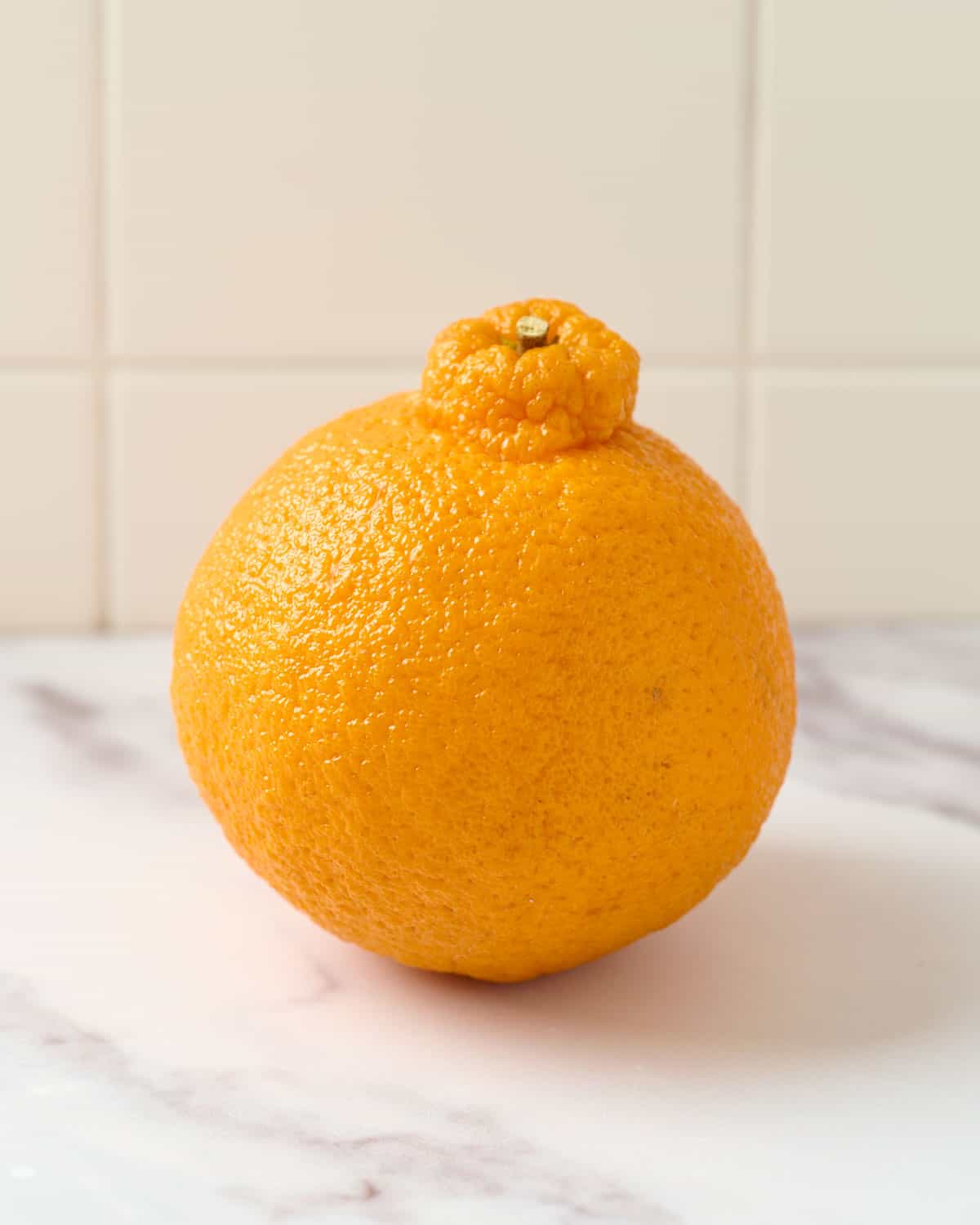
Sumo oranges are naturally very sweet, and larger than most other orange varieties, making them great for juicing if you like a sweeter tasting orange juice. Sumo oranges can be slightly more expensive to purchase because they have more complex needs for growing and have a shorter growing season.
Because these oranges are larger, I recommend juicing them with a citrus reamer or citrus juicer.
| Pros | Cons |
|---|---|
| Large in size, producing more juice | May be overly sweet |
| Juicy and sweet | More expensive to purchase |
Blood Oranges
This orange is known for its beautiful reddish flesh color. Blood oranges have a unique, more tart flavor and can add a punch that is unlike other oranges. Their downside comes from expensive prices.
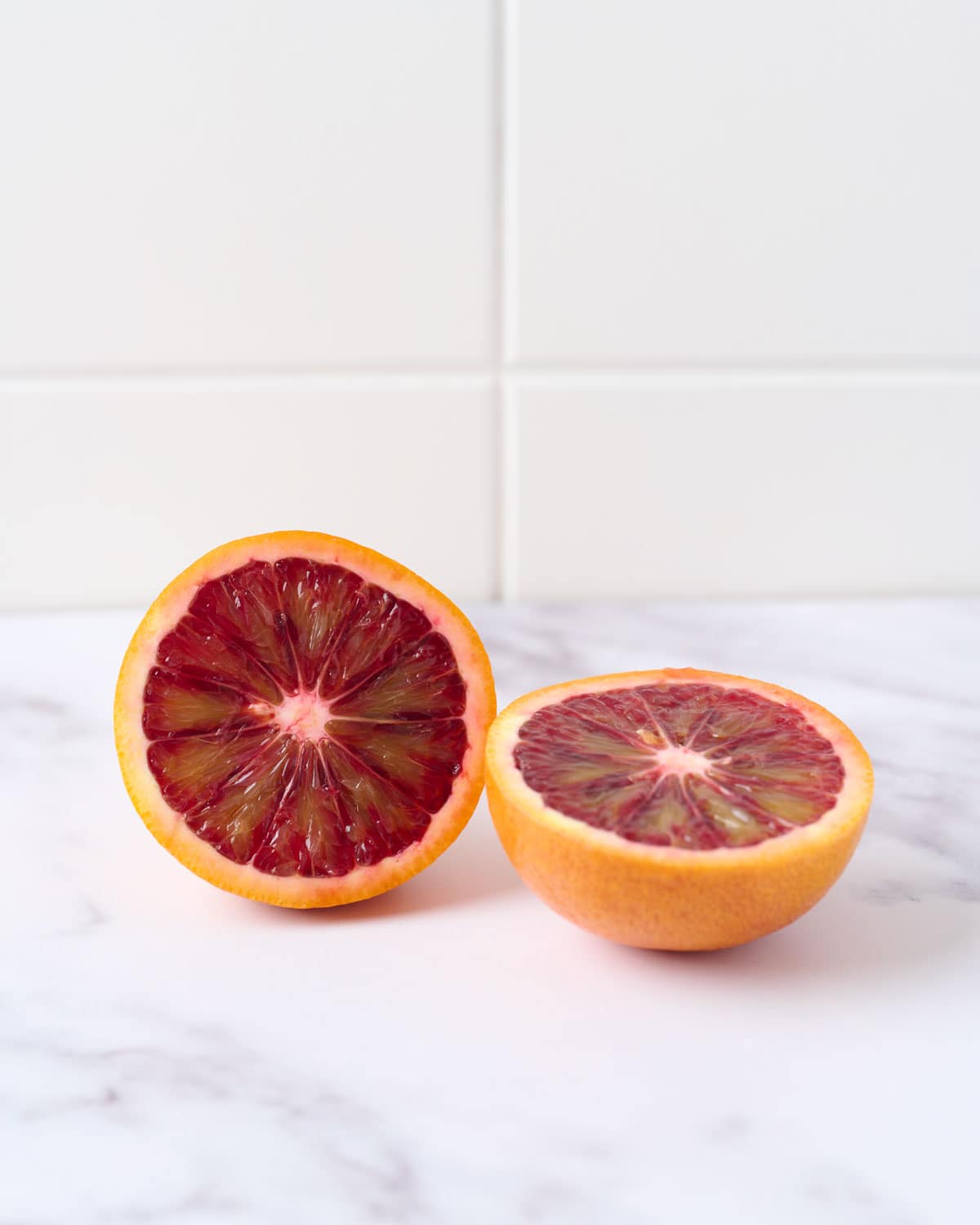
Blood oranges are not for everyone, but if you prefer less sweet orange juice, then I recommend combining this orange variety with another! I honestly love the tart flavor of blood oranges and like them to balance out some of the sweeter more traditional oranges (like valencia or cara cara).
Because blood oranges can be a sometimes smaller variety, I recommend removing the peel and blending them, or using a small citrus reamer for the juice.
| Pros | Cons |
|---|---|
| Tart flavor | More expensive to purchase |
| Unique color | Shorter peak season |
| Great to combine with other oranges | Harder to find in stores |
Navel Oranges
Navel oranges are the most common type of orange. The juice can be so sweet that it ferments if kept in the fridge for over 3 days. If you prefer a sweeter juice, navel oranges are the direction to go, but I definitely suggest you drink it immediately.
Because navel oranges are typically larger, I suggest using a citrus reamer or hand squeezing these.
| Pros | Cons |
|---|---|
| Contain little to no seeds | May be overly sweet |
| Juicy and sweet | May ferment in the fridge |
| Large in size - easy to juice | |
| Cheaper and common to find |
Tangelo Oranges
If you are a citrus lover that is looking for a balance between sweet and tart, look no further than the Tangelo orange! The Tangelo is a hybrid fruit combining a tangerine with a grapefruit/pomelo.
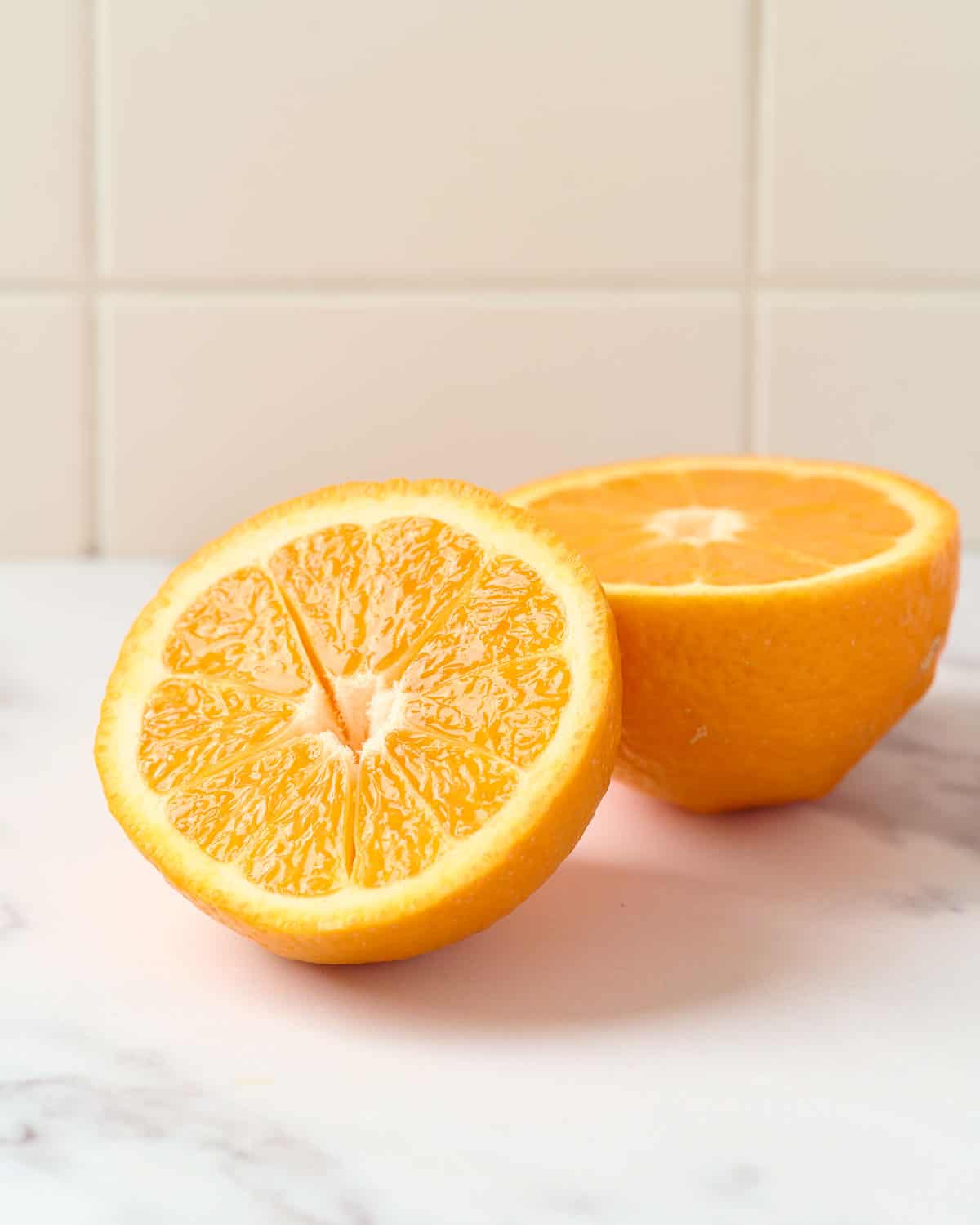
This fruit supplies the sweetness from a tangerine with the tartness and bitterness of a grapefruit while keeping the items on your grocery list to a minimum. I honestly love Tangelos, but I wouldn't suggest them to those who prefer a super sweet orange juice.
Not only are Tangelos perfect for juicing due to their complex flavor, but they are perfect to pair with a Gluten Free Breakfast Sandwich or Huevos con Chorizo for a quick and delicious breakfast.
I love love love tangelos, and I find them to be slightly smaller than the larger varieties, but still larger than mandarins. For these it's easier for me to use a citrus reamer.
| Pros | Cons |
|---|---|
| Sweet and tart | Can contain seeds |
| Thin skin makes them easy to peel | Not edible by those with grapefruit allergies |
| Different varieties offer stronger sweet or tart profiles, depending on personal preference | Variety of flavors can also make it difficult to know what you’re getting |
Hamlin Oranges
Hamlin oranges are a great orange for juicing due to their delicious juice and sweet flavor. They are a popular choice among citrus enthusiasts who appreciate the perfect balance of sweetness and tartness that these oranges offer.
Unlike other orange varieties such as the blood orange or Seville orange, Hamlin oranges are known for their sweet taste while not tasting quite as sweet as a Navel or Valencia. This makes them a versatile choice for juicing, as their balanced flavor profile can be enjoyed on its own or mixed with other citrus or fruit juices such as pineapple oranges or cara cara oranges.
| Pros | Cons |
|---|---|
| Large in size - easy to juice | May be harder to find |
| Juicy and sweet | May not be sweet enough for some |
| Contain little to no seeds | |
| Tart flavor that balance sweetness |
Lima Oranges
Lima oranges are a fantastic choice when it comes to finding the best oranges for juicing. With their vibrant orange color and sweet flavor, they are a popular pick for making orange juice. Lima oranges belong to the sweet orange variety, which includes the well-known navel and Valencia oranges.
The lima orange has a slightly tart flavor that adds a refreshing twist to freshly squeezed orange juice. They have a high juice yield, making them highly efficient for juicing purposes. Whether you are using a citrus juicer or an orange juicer, extracting juice from Lima oranges is a breeze.
The absence of high pulp content makes them an ideal choice for those who prefer a smooth juice without any chunky bits. Lima oranges also have a thinner peel, reducing the chances of any unwanted bitter taste or strong citrus aroma from the orange peel contaminating the juice.
Because they have such a thin peel, I recommend using a citrus reamer.
| Pros | Cons |
|---|---|
| Contain little to no seeds | May be harder to find |
| Juicy and sweet | Not as good for pulp lovers |
| Thin peel | |
| Low pulp content |
Pineapple Oranges
The Pineapple Orange is a Florida staple and one that has been grown in the state for more than 150 years. The name comes from the sweet, pineapple scent that the blossoms of the Pineapple Orange trees give off, and the oranges themselves and are famous for their tropical aromatics and sweet taste as well.
| Pros | Cons |
|---|---|
| Unique sweet and tropical flavor | May be harder to find |
| Great with other citrus and tropical fruit juices | Delicate and can bruise easily |
| Tropical twist to orange juice |
Seville Oranges
Seville oranges are very unique when compared to other oranges due to their bitter flavor. They are often used to create orange liqueurs and spirits, such as Triple Sec and Curacao.
Seville oranges can provide a deeper, more complex flavor to whatever you are making rather than simply supplying the sweetness that many of the previously mentioned oranges bring to the table.
In addition to orange liqueurs, Seville oranges are often commonly used in baking, making marmalades, and preserving/pickling. If you’re looking for a sweeter juice when using Seville oranges, I would recommend combining with another traditionally sweeter orange, such as a Hamlin or Navel orange.
| Pros | Cons |
|---|---|
| Bitterness adds unique complexity | Can be overly bitter when used alone |
| Juicy | Thick pith can make juicing tedious |
| Strong citrus fragrance | May be harder to find |
Tips for Juicing Oranges
There are multiple ways to juice oranges, which can vary in how time consuming the process is and also depends overall on which oranges you choose to juice. Check out more information here for a more detailed recipe on how to make freshly squeezed orange juice!
Choose the Right Orange for your Taste
Now that we have gone over 13 types of oranges you can use to juice, you realize there is not one great choice but thirteen! Choose the right orange for your taste - whether it be a sweet orange for a sweet juice or a more tart combination.
Pick up a few different types at your local store to try before deciding which orange you want to use to make a whole pitcher of juice with or to marinate your meat in. This will save you both time and money.
Pick your Juicer
Depending on the size of your oranges or the quantity of juice you plan to make, there are a variety of methods you can use to juice your oranges.
- Squeeze by hand - the best option for large oranges with little to no seeds, such as Navels, Valencias, and Cara Caras. No special tools are required!
- Hand held squeezer - these are cheap and can speed up the juicing process for medium-sized oranges and other citrus fruit such as lemons or limes.
- Citrus juicer or Citrus Reamer - these are also cheap and only require you to press the cut side of the orange against the blade and twist! Citrus reamers are also a great way to keep pulp out of your juice if you’re not a fan.
- High-Powered Blender (affiliate link) - great for small oranges that would otherwise take forever to juice by hand or with a squeezer and cause plenty of hand cramps, such as Mandarins or Clementines. If using the blender with larger oranges, there usually is a lot of pulp as a result that needs to be sieved, which is why I would not recommend it for larger oranges. Just remember to remove the peel of oranges prior to adding to the blender as the peel will add a bitter taste to the fresh orange juice.
- Centrifugal Juicer (affiliate link) - the fastest and easiest way to juice fruit and veggies, but I usually do not recommend using a centrifugal juicer (affiliate link) to juice citrus. I find that electric juicers don’t do as well of a job on juices that are solely citrus and are better for fruit and vegetable juices that combine multiple ingredients. If you do want to use your juicer, make sure to remove the peels of oranges prior as it’ll help the process!
Store the Juice Properly
Once you have your juice, be sure to properly store any leftovers in a clean, airtight container inside your refrigerator at 40°F (4°C) or lower. The tighter the seal on your container is, the longer your juice will last due to minimal air exposure. You can also freeze your juice and thaw at a later time in the fridge or at room temperature, but the flavor and consistency of the juice will be altered after freezing.

Read my in-depth article to learn how long your orange juice will last in the fridge and how best to preserve it.
Experiment
The great thing about oranges is that you can try combining multiple varieties together! For example, clementines and blood oranges varieties are great to combine with other oranges. You can also try other citrus fruit too, like a grapefruit orange juice or my mandarin juice that adds lemon!
What’s in Season
Remember that many states have different seasons for fruits and when they will be freshest for you. Especially when making orange juices, seasonality is a big consideration, so choose an in-season variety! Read more about what’s in season for you.
FAQs
Yes, it is generally recommended to peel oranges before juicing, only if using a conventional juicer or blender. The orange peel can add bitterness to the juice and may affect its taste. Additionally, the peel contains oils that may not be desirable in the juice. However, if you have a specific recipe that calls for the inclusion of orange peel, then peeling may not be necessary.
It is generally agreed that Valencia oranges have the most juice and are the best orange for juicing. Valencia oranges are known for their high juice content and are often referred to as juice oranges. They have a thin skin, few seeds, and are typically very juicy, making them an excellent choice for juicing purposes.
The most commonly used oranges for orange juice are the Valencia oranges and the Navel oranges. Valencia oranges are often preferred for their juiciness and tangy flavor, while Navel oranges are known for their sweetness. Both varieties yield a high juice content and are popular choices for commercial orange juice production.
Yes, mandarin oranges are good for juicing. They have a sweet and tangy flavor that adds a refreshing taste to fresh juices. Mandarin oranges are also easy to peel and have a high juice content, making them a popular choice for juicing. However, to make mandarin orange juice, I recommend blending them.
Store any leftover juice in an airtight container inside your refrigerator at 40°F (4°C) or lower. You can also freeze your juice and thaw at a later time in the fridge or at room temperature, but the flavor and consistency of the juice will be altered after freezing. Read my in-depth article to learn how long your orange juice will last in the fridge and how best to preserve it.
Recipes using Oranges
- Grapefruit Orange Juice
- Orange Agua Fresca (Agua de Naranja)
- Mandarin Juice
- Carrot Ginger Turmeric Juice
- Green Goddess Juice
- Dutch Oven Barbacoa
- Dutch Oven Carnitas (Authentic Mexican Carnitas)
- Spicy Skinny Margarita
- Kale Quinoa Salad with Orange Ginger Dressing
- Carne Asada Quesadillas
- 3 Ingredient Skinny Margarita


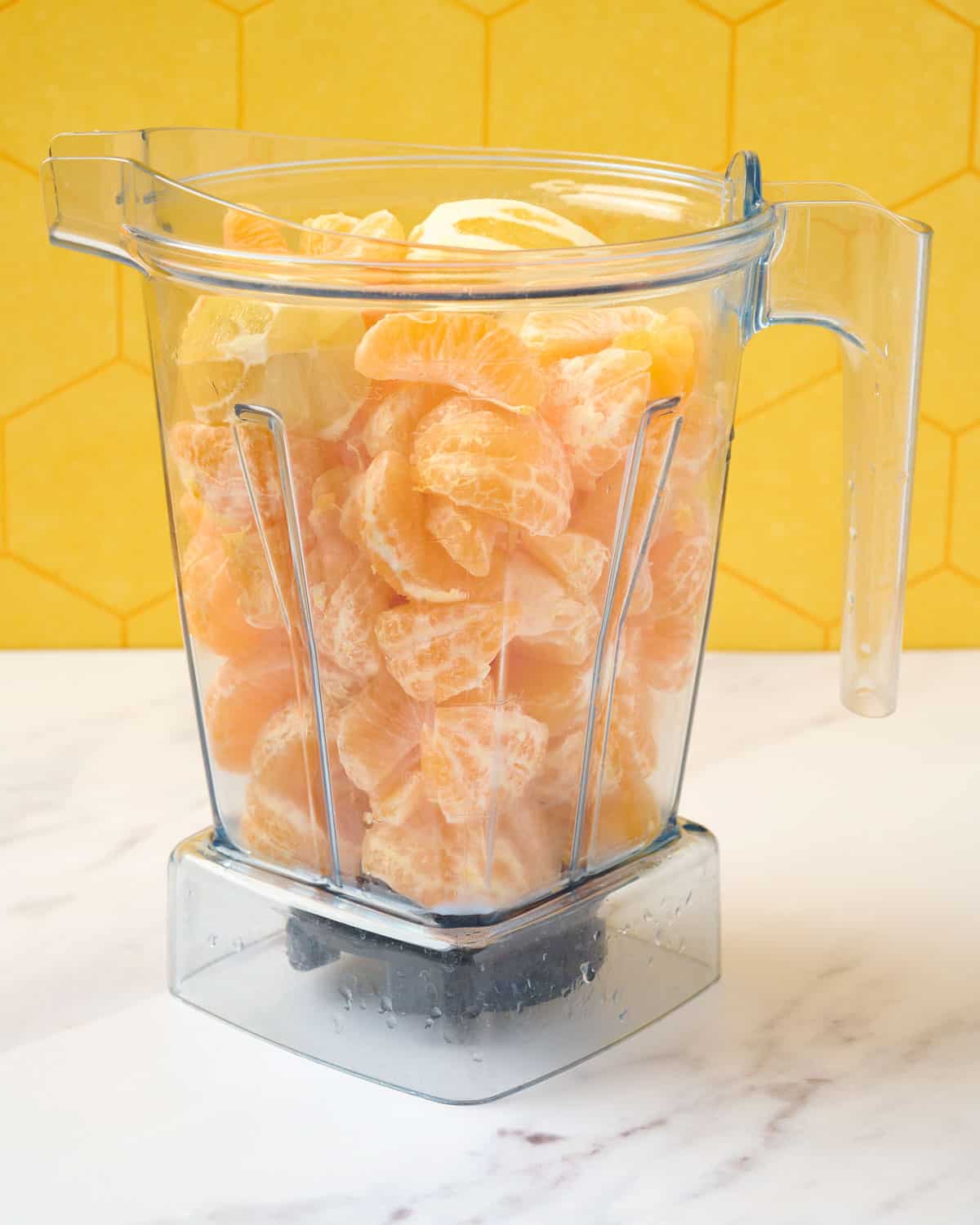
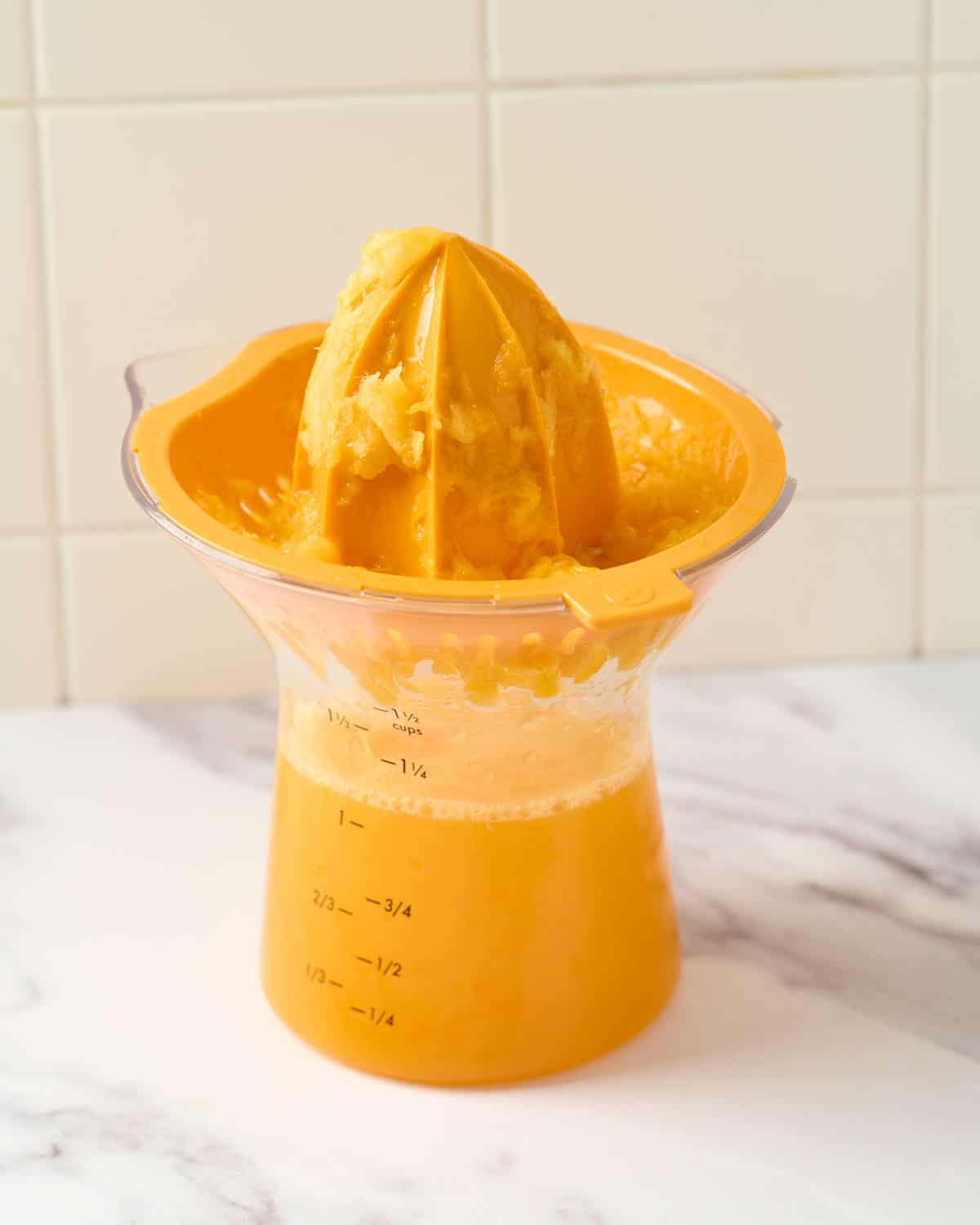



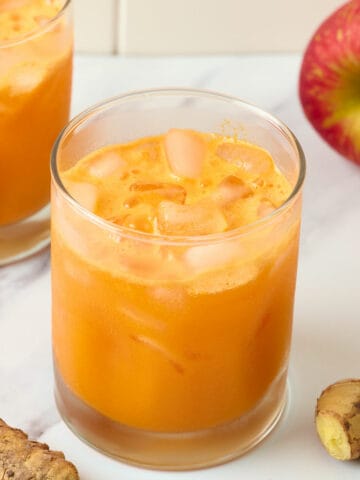
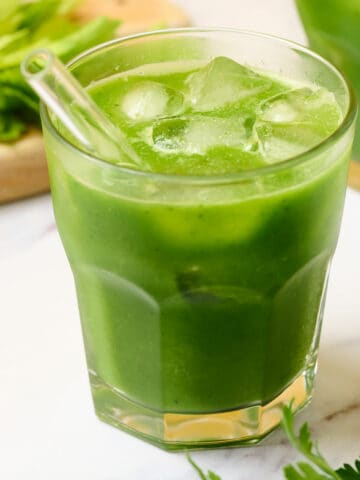
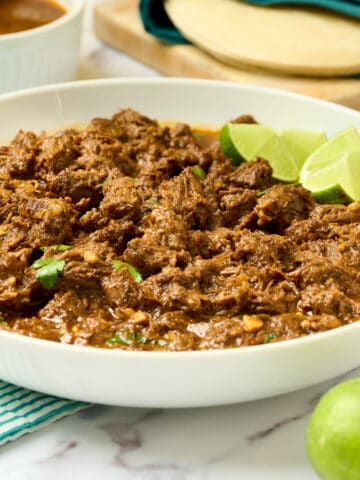
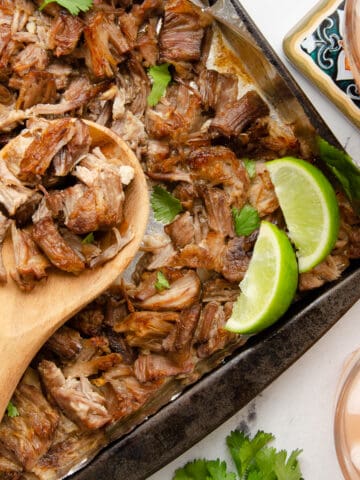
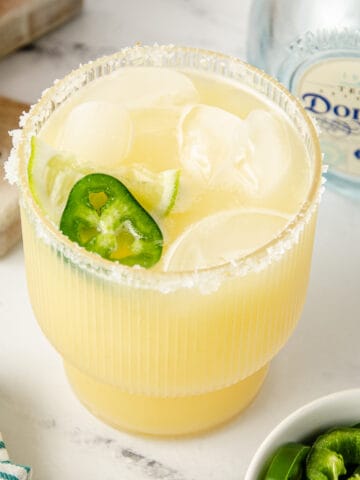
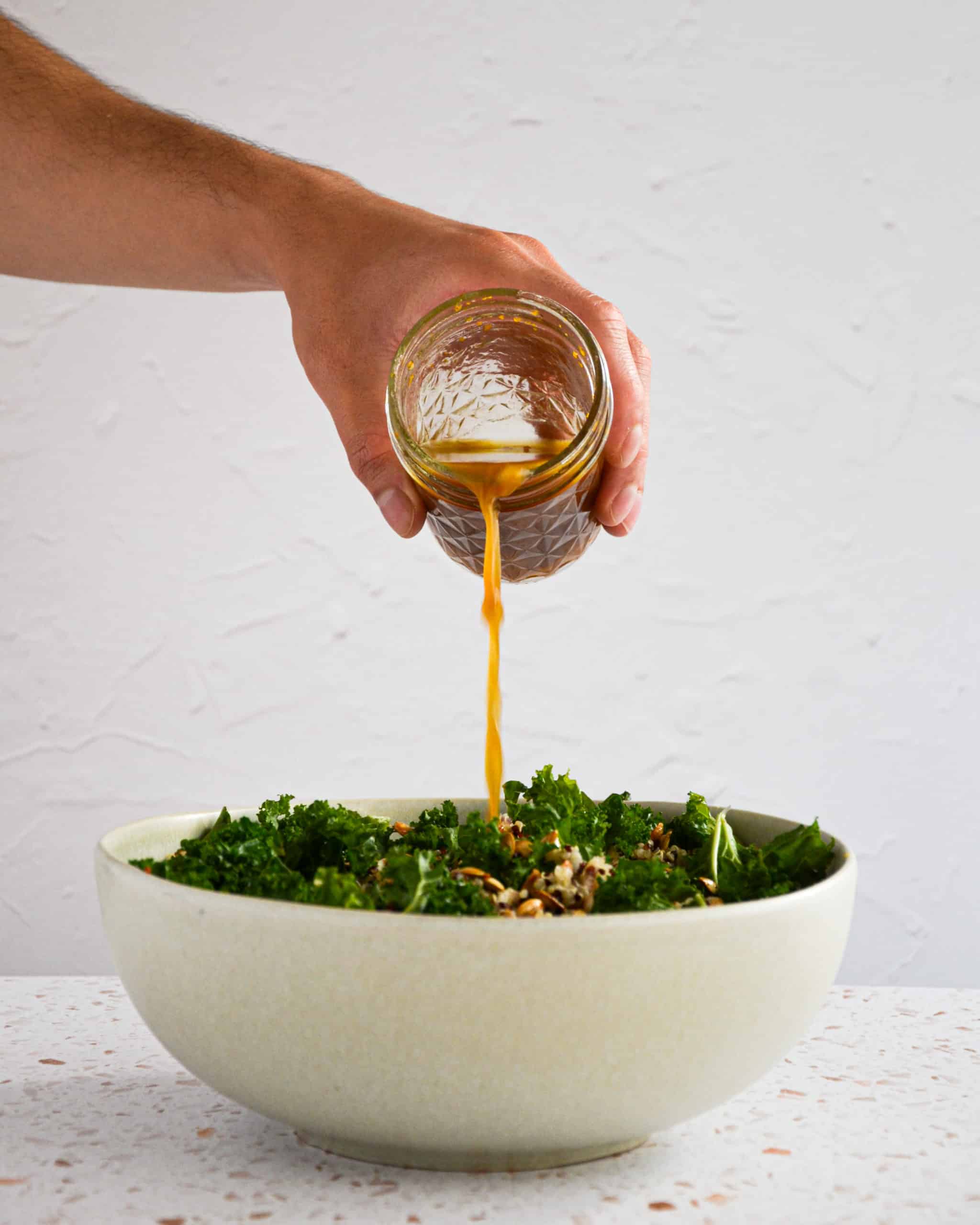
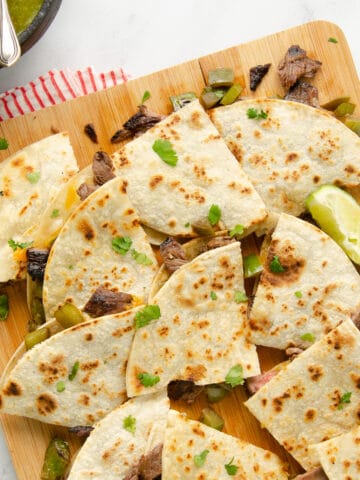
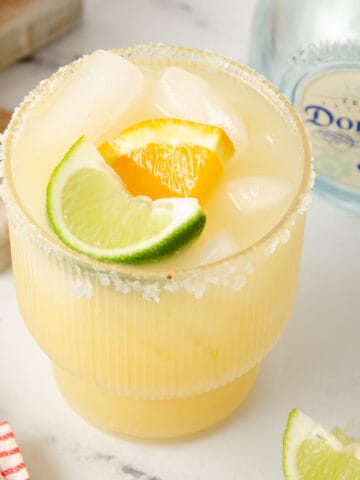

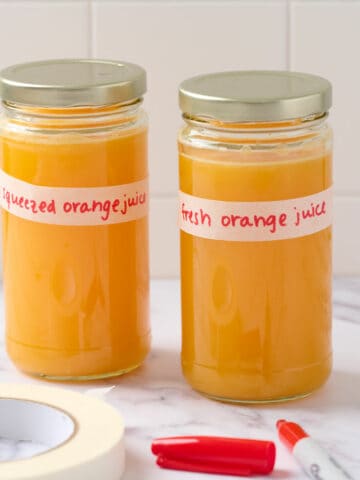
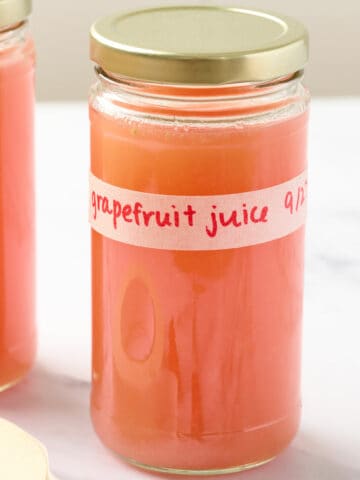
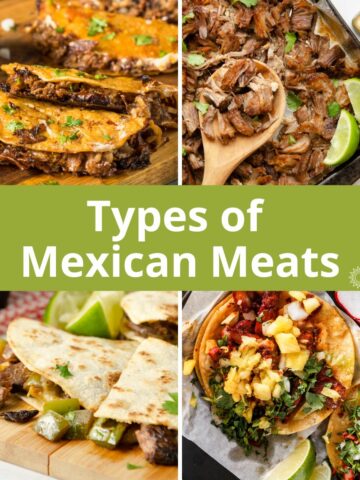
Comments
No Comments